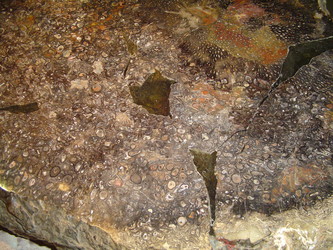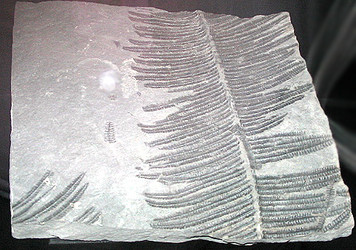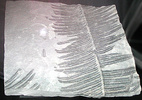Asterothecaceae
Maarten Christenhusz



This tree diagram shows the relationships between several groups of organisms.
The root of the current tree connects the organisms featured in this tree to their containing group and the rest of the Tree of Life. The basal branching point in the tree represents the ancestor of the other groups in the tree. This ancestor diversified over time into several descendent subgroups, which are represented as internal nodes and terminal taxa to the right.

You can click on the root to travel down the Tree of Life all the way to the root of all Life, and you can click on the names of descendent subgroups to travel up the Tree of Life all the way to individual species.
For more information on ToL tree formatting, please see Interpreting the Tree or Classification. To learn more about phylogenetic trees, please visit our Phylogenetic Biology pages.
close boxIntroduction
The carboniferous was often described as the “Age of Ferns”, however it is now known that some of these fern fossils actually belonged to early gymnosperms, because they were found in association with seeds. One can however not be certain about sterile fronds, and these have been placed in a number of form genera. One of these form genera is Pecopteris, with a large number of described species known. Some of these were certainly gymnosperms, while others were certainly Marattioid ferns, because they bore sori of thick-walled sporangia. These fronds, sometimes as large as 6 m long, were many times pinnate, and the pinnules were attached along their entire base, each with a single midrib. The lateral veins were branched dichotomously once or twice or remaining simple, a venation type that is very similar to most extant Marattiales.
Asterotheca is the name given to pecopterid fronds bearing sessile sori made up of four or five sporangia fused at the base into a synangium, but with the distal part free. The sori were commonly arranged in two series along the pinna, each associated with a veinlet in the lamina. Example: Asterotheca candolleana.
Scolecopteris was similar to Asterotheca, except that the sorus was elevated on a short pedicel, or receptacle. Example: Scolecopteris incisifolia.
Fronds of the types above are often found in association with stout trunks, having a superficial resemblance to modern tree-ferns. These had a remarkably complex stelar anatomy and are generally referred to as Psaronius. Some of these were as much as 75 cm across, but most of this width was occupied by a thick root mantle. The stele of most Psaronius fossils (and in fact also most modern Marattiales) is a polycyclic dictyostele which, in the more complex types, contains as many as eleven interconnecting coaxial cylinders. Each cylinder is dissected into a number of mesarch meristeles completely surrounded by phloem, and the leaf traces at any particular level arose from the outermost system, while the inner systems were concerned with the origin of leaf traces at higher levels. The earliest examples had a simpler internal anatomy. Psaronius renaultii for instance had an endarch solenostele.
References
Christenhusz, M. J. M. 2007. Evolutionary History and Taxnomy of Neotropical Marattioid Ferns: Studies of an ancient lineage of plants. Annales Universitatis Turkuensis ser. AII, tom. 216, pp. 1-134.
Sporne, K. R. 1962. The morphology of pteridophytes, the structure of ferns and allied plants, pp. 127-135. Hutchison & Co. London.
Title Illustrations

| Scientific Name | Psaronius sp. |
|---|---|
| Location | Petrified forest, Kulturkaufhaus Tietz, Chemnitz, Germany |
| Specimen Condition | Fossil |
| Body Part | stem base |
| View | cross-section |
| Source | File:Petrified-Forest-Chemnitz1.JPG |
| Source Collection | Wikimedia Commons |
| Image Use |
 This media file is licensed under the Creative Commons Attribution-ShareAlike License - Version 2.5. This media file is licensed under the Creative Commons Attribution-ShareAlike License - Version 2.5.
|
| Copyright | © 2006 Kolossos |
| Scientific Name | Psaronius sp. |
|---|---|
| Creator | Fotografía digital realizada por Pablo Alberto Salguero Quiles |
| Specimen Condition | Fossil |
| Source | File:Psaronius.jpg |
| Source Collection | Wikimedia Commons |
About This Page
Maarten Christenhusz

The Natural History Museum, London, United Kingdom
Correspondence regarding this page should be directed to Maarten Christenhusz at
Page copyright © 2009 Maarten Christenhusz
 Page: Tree of Life
Asterothecaceae.
Authored by
Maarten Christenhusz.
The TEXT of this page is licensed under the
Creative Commons Attribution-NonCommercial License - Version 3.0. Note that images and other media
featured on this page are each governed by their own license, and they may or may not be available
for reuse. Click on an image or a media link to access the media data window, which provides the
relevant licensing information. For the general terms and conditions of ToL material reuse and
redistribution, please see the Tree of Life Copyright
Policies.
Page: Tree of Life
Asterothecaceae.
Authored by
Maarten Christenhusz.
The TEXT of this page is licensed under the
Creative Commons Attribution-NonCommercial License - Version 3.0. Note that images and other media
featured on this page are each governed by their own license, and they may or may not be available
for reuse. Click on an image or a media link to access the media data window, which provides the
relevant licensing information. For the general terms and conditions of ToL material reuse and
redistribution, please see the Tree of Life Copyright
Policies.
- First online 23 January 2009
- Content changed 23 January 2009
Citing this page:
Christenhusz, Maarten. 2009. Asterothecaceae. Version 23 January 2009 (under construction). http://tolweb.org/Asterothecaceae/56839/2009.01.23 in The Tree of Life Web Project, http://tolweb.org/









 Go to quick links
Go to quick search
Go to navigation for this section of the ToL site
Go to detailed links for the ToL site
Go to quick links
Go to quick search
Go to navigation for this section of the ToL site
Go to detailed links for the ToL site